Abstract
Pin-on-disk tests were performed to evaluate the wear behaviour of a 2024 aluminium alloy metal matrix composite (MMC) reinforced with 52 vol.% of TiC particles (Al-2024/TiC) in a fabricated and thermal-treated (T6) condition. The MMC was produced via pressureless infiltration of partially sintered TiC preforms with an average particle size of 1.1 μm at 1200 °C for 2 h under flowing argon. Microstructural and mechanical characterisation were carried out on both the monolithic alloy (MM) and the MMC with and without heat treatment. The effect of T6 heat treatment on the tribological behaviour of MMC has been investigated under dry sliding wear conditions under normal loads of 2, 5 and 10 N against ceramic α-Al2O3 and SAE 52100 steel spherical counterparts. Results indicate a substantial improvement in the microhardness (289–343 HV), hardness (25–34 HRC), and wear resistance of the MMC after T6 heat treatment (1 × 10−3 to 5 × 10−5 mm3/Nm). For a better understanding of the wear mechanisms, surfaces of the worn tracks were studied. Oxidation and abrasion were found as the dominant wear mechanisms in both MM and MMC samples. Even though MM exhibited a lower coefficient of friction (COF) (0.50–0.80), composites showed superior wear resistance by 5-fold higher than the base alloy.
1. Introduction
Nowadays, technological developments in automotive and aerospace applications demand lighter materials with superior performance to realise more efficient engineering operations. In this context, Al-based MMCs have gained much attention due to their high strength/density ratio and satisfactory levels of corrosion and wear resistance, including lighter weight, the ability to tailor lay-ups for optimum strength and stiffness, and improved fatigue life [1,2,3,4,5]. In addition, the use of heat-treatable Al alloys as matrices enables enhancement of the mechanical properties of the MMCs as a result of the hardening of the alloy due to the precipitation strengthening mechanism [6,7,8,9,10,11,12]. Particularly, Al-2024 has been the most widely used alloy in the 2XXX series in aerospace and automotive applications due to its properties (high specific strength, fracture toughness, fatigue resistance, and thermal shock resistance), especially in the heat treatment condition. The alloy 2024-T3 sheet is commonly used for fuselage skins, where it is Al clad for corrosion protection [1,2,3].
Al-metal matrix composites (MMCs) reinforced with ceramic particles and processed by conventional routes offer enhancement of properties. The feasibility of using MMCs in the above areas can be explored by assessing its tribological behaviour in wear conditions to judge their suitability as potential materials to arrest the wear of two surfaces. Usually, many ceramics particles have been added to Al matrices as reinforcement such as Al2O3, TiO2, SiC, AlN, TiC, TiB2 and B4C [13,14]. There has been a growing interest in the development of technologies for Al composites reinforced with TiC particles due to its high and superior mechanical and physical properties such as high hardness, elastic modulus, low density, relatively high temperature stability and good wettability with Al [15,16].
The tribological behaviour of MMCs has been studied by many authors [1,14,17,18,19,20,21,22,23]. Data related to the wear behaviour of Al-based MMCs indicated an improvement in this property with respect to the monolithic alloy because of the incorporation of hard ceramic particles. The factors that have a strong influence on wear behaviour are the type, size and volume fraction of particles as well as the interfacial particle/matrix bonding [24,25,26]. Veeravalli and Tyagi et al. [17,27] performed tribological characterisation of in situ Al-TiC composites under dry sliding wear conditions. Their results showed that the presence of the TiC particles increased the resistance of the composites even for low volume fraction of particles. Other investigations have been carried out looking at the effect of operating conditions on the tribological properties of Al and Al-based MMCs. For example, Mohammad et al. [28] evaluated the effect of the sliding speed and normal load in an aluminium disk against stainless steel counterparts. The results showed that the value of the coefficient of friction and the wear rate increased with increasing sliding speed and normal load. Sharma et al. [19] studied the wear behaviour of sillimanite (Al2SiO5)-reinforced MMCs with pin-on-disc tests under different normal loading conditions. The results showed that the wear rate increased at high loads and the wear coefficient decreased when the sliding distance increased. Surappa et al. [20] reported that the wear rate and friction coefficient vary with both applied normal load and sliding speed. Jerome et al. [21] found that the wear rate increases as a function of the applied load and decreases with the content of TiC. Gopalakrishnan [22] evaluated the wear properties of Al 6061–TiC alloy before and after introducing TiC particles. Their results showed that the wear rate increased with normal load and sliding speed for all the conditions. Further, the wear rate of the Al 6061-TiC composites was slower than that of the Al-6061 matrix. Similarly, Kumar et al. [14] evaluated the weight loss and the coefficient of friction of TiC-reinforced Al-4.5%Cu in situ MMCs and found a significant improvement in the mechanical properties and wear resistance as compared to the matrix. Modi [23] reported that the load and speed on the sliding friction coefficient of Al-Cu reinforced with 10 vol.% Al2O3 particles are the factors that have a significant effect on the tribological response. Finally, Zhang et al. and Kaushink [18,29] reported for A6061 and A6018 matrices reinforced with ceramic particles that a heat-treated T6 condition exhibited better wear properties as compared to the monolithic alloys.
In this study, an investigation has been made to characterise the microstructure and tribological behaviour of an Al-2024/52%TiC MMC in the as-fabricated and heat-treated conditions. The wear rate was evaluated with respect to different loads by using ceramic and steel balls in the unreinforced Al-2024 alloy and Al-2024 MMC reinforced with 52 vol.% of TiC particles with and without T6 heat treatment using pin-on-disc tests. Considerable attention was paid to determine the wear mechanism and the understanding of observed reinforcing effect.
2. Materials and Methods
2.1. Materials and Processing
The metal matrix used in this study was a commercial 2024 aluminium alloy (Thomson Aluminium Casting Co., Cleveland, OH, USA), with the chemical composition shown in Table 1. Titanium carbide particles (Atlantic Equipment Engineers Co., Ltd., Upper Saddle River, NJ, USA) with an average size of 1.1 µm were used as the reinforcing phase. Porous green preforms of TiC (6.5 × 1 × 1 cm3) were obtained by compacting 12 g of TiC powder into a steel die applying 15 MPa. The TiC green preforms were sintered at 1350 °C over 1.5 h in an inert atmosphere of Ar. Figure 1 shows micrographs of raw and partially sintered TiC preform at 1350 °C. Notice the formation of an interconnected network was perceived in the preform after sintering. No changes in the TiC morphology were detected but more densification and pore shrinkage were observed. The density and porosity of the sintered preforms were evaluated according to ASTM C373-88 [30]. Finally, MMCs was manufactured by a pressureless infiltration technique in a horizontal tube furnace at 1200 °C by placing the sintered TiC preform and the Al-2024 alloy in a graphite crucible for 2 h under flowing Ar.

Table 1.
Chemical composition of the Al-2024 alloy (wt.%).
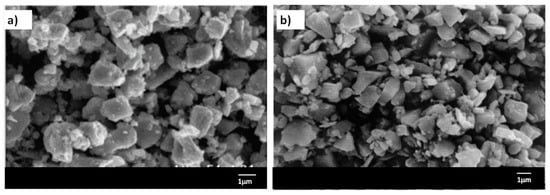
Figure 1.
Morphology of the (a) raw TiC powder and (b) sintered TiC preform at 1350 °C.
2.2. Heat Treatment
In order to determine the effect of microstructural transformations on the tribological behaviour of the MMC, samples were subjected to a T6 heat treatment. The solution heat treatment of the samples was carried out at 530 °C over 150 min in Ar followed by water quenching. For artificial aging, the samples were heated to 190 °C and held at that temperature for 12 h in Ar. These conditions were selected according to the best mechanical properties obtained in previous work [10,31].
2.3. Microstructural Characterisation
Prior to the microstructural characterisation, samples of the MMC were ground with SiC emery paper up to 2000 grit and polished to a mirror-like surface with diamond pastes (6, 3 and 1 μm). In order to evaluate any microstructural change due to the T6 heat treatment on the Al-2024/52%TiC composites, samples were observed as-infiltrated and in the T6 heat treatment condition in a JEOL JSM-6400 scanning electron microscope (SEM) equipped with energy dispersive X-ray spectroscopy (EDX). X-ray diffraction analyses were also conducted for both conditions using CuKα radiation with λ = 1.54060 Å, 40 keV and current emission of 20 mA in 2θ range from 20° to 90°, with a step size of 2° and a dwell time of 1 s in a Siemens D5000 diffractometer.
2.4. Mechanical Properties
Vickers microhardness measurements were carried out in a Zwick/Roell ZH equipment by applying a load of 100 gf over 10 s. The test was conducted at room temperature and the indents were made, at least, in five different places on each sample to obtain a mean value of hardness according to ASTM E384 [32].
Tensile test specimens were precision machined to conform to standard specified in ASTM: E-8-81. Uniaxial tensile tests were performed at room temperature using an Instron testing machine (model 810) at a constant strain rate of 5 × 10−5 m/s−1. Tensile properties: yield strength (YS), ultimate tensile strength (UTS), and elongation (EL) were obtained. (The details of the Tensile test were discussed in [10]). The elastic modulus was measured with Grindosonic MK5 (Lemmens) equipment, in which three bars of the composite were prepared to obtain a representative average, measurements in each of the four faces were performed.
2.5. Sliding Wear Testing
The tribological behaviour of the MMC samples of dimensions 1 × 1 cm2 was evaluated in an Anton Paar pin-on-disk apparatus with a pin-on-ball coupling attachment according to the ASTM G99-95 standard [33] as shown in Figure 2. The test conditions included a constant disk rotation of 0.03 m/s. Balls of hardened 52100 steel and α-Al2O3 of 3 mm in diameter were chosen as the counterface material by previous experience of the authors in wear studies of Al composites reinforced with carbide compounds [34]. The hardness of 52100 steel and the ceramic Al2O3 is 850 and 2000 HV, respectively. Considering that the maximum hardness of the MMC was ≈350 HV, the wear volume of both 52100 steel and ceramic Al2O3 counterface material during the sliding process could be negligible. It was more convenient for us to investigate the tribological properties of the MMC composite materials without considering the wear of counterfaces. Wear tests were performed with loads of 2, 5 and 10 N. The wear experiment was repeated three times with each loading condition. All the wear tests were run for 113 m under dry sliding at room temperature and a relative humidity of 45 ± 2%.
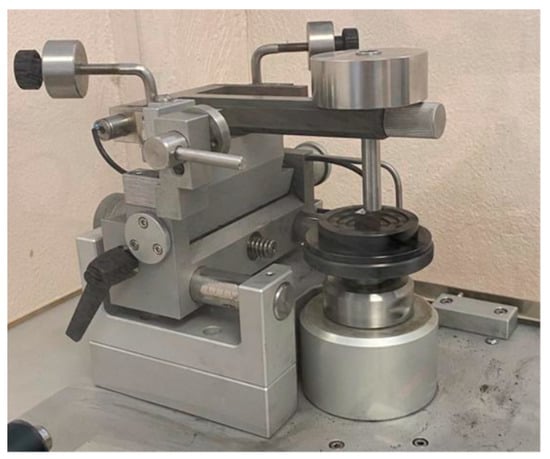
Figure 2.
Pin-on-disc sliding wear tester.
To evaluate the wear mechanism, samples were observed in the SEM and in a Nanovea PS50 optical profilometer. The specific wear rate was obtained applying Archard’s equation [35].
where K is the specific wear rate coefficient (mm3/N-m), V is the wear volume (mm3), C is the normal load (N) and S is the sliding distance (m).
3. Results
3.1. Microstructure of the Composites
Figure 3a–c show the characteristic microstructure of the as-infiltrated samples of MMC as observed in the SEM in the backscattered mode. A plane view of the 3D network formed by the angular TiC particles, light grey phase, during partial sintering is seen along with the matrix, dark phase, filling the interstices between particles of the initially porous TiC preform. Area fraction measurements indicated that the Al-based composites are reinforced with an approximate content of 52 vol.% of TiC phase. This estimation is quite consistent with porosity measurements of the TiC preform by the Archimedean principle and through image analysis, which matched the TiC volume fraction to the TiC preform before infiltration. Very low levels of residual porosity were observed in the as-infiltrated composite; and according to density measurements, these values were between 2 and 3%. No discontinuities such as aluminium veins were observed and most of the matrix/particles interfaces were free of bulk reaction products, indicating a good interfacial adhesion between the constituents of the composite. SEM observation also reveals a constant pattern of TiC particles in the MM with a non-apparent interfacial reaction. The EDS results confirmed that the most predominant phases in the matrix were Al3Ti and TiC particle phases distributed in the matrix (Al 2024) in samples of as-infiltrated and heat treatment (T6) conditions.

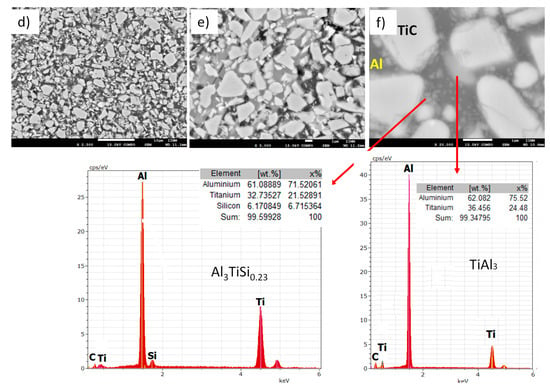
Figure 3.
SEM micrographs of composites (a–c) as-infiltrated and (d–f) after heat treatment. EDX spectra and chemical composition of the precipitated phase observed in Figure 3f.
The larger amount of phase precipitated of Al3Ti in the metallic matrix of the as-infiltrated samples Figure 3a–c compared to the smaller amount of second-phase precipitates in samples after heat treatment (T6) (Figure 3d-f) was evident. This is because during the heat treatment, the precipitate in the metallic matrix was dissolved and homogeneously distributed after solution treatment and artificially aged [10]. These results were previously reported by other authors [9,17,35].
The microstructure of the MMC after the T6 heat treatment is shown in Figure 3d,e). In addition to the observed features of the as-infiltrated MMC, some TiC particles seem to be embedded in a phase different to the Al-2024 matrix. To ascertain the identification of this phase, EDX analysis was performed, and the spectra and quantification of this phase are shown in Figure 3f). This phase was found to be a TiAl3Si0.23 intermetallic randomly precipitated throughout the MMC. In Al/TiC composites, the precipitation of TiAl3 is quite common [36]; however, when the aluminium matrix is alloyed with Si, this element partially replaces Al atoms, resulting in a complex Ti-Al-Si sub-stoichiometric compound with the same crystalline structure to TiAl3 [37]. The reaction between TiAl3 and Si can be expressed according to [38] as:
where x: stochiometric amount of Si.
TiAl3 + 3xSi→TiAl3Si3x
From EDX results, the value of x is deduced as 0.077. Then, Equation (2) turned into
TiAl3 + 0.23Si→TiAl3Si0.23
The presence of precipitates TiAl3 and TiAl3Six correlate with the observation of [10,11,36,37,38] but no evidence of precipitates CuAl2 and Al4C3 were observed as was reported previously [15].
Figure 4 shows the XRD patterns of the as-infiltrated and heat-treated Al-2024/TiC composites. The corresponding diffraction peaks for TiC and Al were identified, with a slight shift in the reflections of Al due to solid solution effects. In the XRD patterns of both samples, there is a peak with low intensity. Analysis of the spectrums revealed a close match of the second main reflection of the standard for the TiAl3 phase. It is assumed that this peak corresponds too to the Ti-Al-Si complex intermetallic seen in the SEM. Partial replacement of the Al atoms with Si decreases the lattice parameter of the TiAl3 phase and shifts the X-ray reflections to higher 2Ө angles [36,37]. The microstructural characterisation of the Al-2024/TiC composites indicates that during and under the infiltration and heat treatment conditions no bulk reactions were induced between the TiC particles and the Al-2014 matrix. The Ti-Al-Si intermetallics are most likely formed by dissolution of free Ti, contained in the TiC powder, into the Al melt during infiltration and, upon cooling and freezing, solubility decreases in Ti in Al gives rise to these intermetallics precipitation [10,31,39]. Nevertheless, after T6 heat treatment, an additional phase was found, corresponding to the reflection peak of TiAl3, as effect of the interfacial reaction between MM and TiC, typical phase reported in the system Al-Ti-C [10,15,31] as well as the detrimental Al4C3 [40] but this last phase was not detected in the X-ray diffraction study.
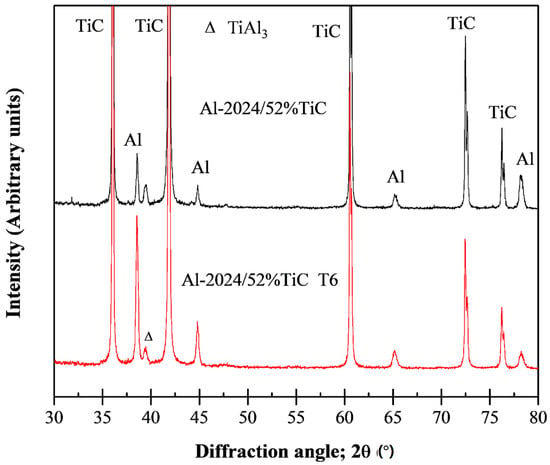
Figure 4.
XRD patterns for as-infiltrated and heat-treated composites.
3.2. Mechanical Properties
Table 2 shows the microhardness (HV0.1) and hardness HRC values of the monolithic MM and the MMC-Al-2024/TiC in the MMC and after T6 heat treatment. An increment of 220% on the HV and 140% on HRC was observed in the MMC-Al-2024/TiC with respect to the MM (127 HV), whereas after T6 heat treatment the maximum value rich an additional increase of 27%. The additional increasing on the HV and HRC values of the samples is attributable to the precipitation promoted by the T6 heat treatment in both MM and the interfacial reaction between constituents. These observations indicate that the increase in hardness values cannot be attributed to the influence of the TiC particles acting as barriers on the plastic deformation of the MM only. In the MM the effect of the T6 heat treatment involve the precipitation of fines particles that block the dislocation movements and promote the Ginner–Preston (GP) zones [10,11,26,41,42,43], whereas in the interfacial reaction, the precipitation of the TiAl3-Si-phase increases the mechanical properties in terms of hardness [11,40,44,45]. The hardness efficiencies of the tested samples are in the range 289–343 HV and 25–34 HRC. It is important to mention that important variations in the values of hardness measured along the bar were not observed, which is an indication that the composites are homogeneous and thus have homogeneous distribution of particle reinforcement.

Table 2.
Effect of T6 heat treatment on the tensile properties and hardness values of the MM and the MMC-Al-2024/TiC, before and after T6 heat treatment.
The characteristics of the tensile behaviour of the composites are shown in Table 2 also. It can clearly be seen that, except for the ductility, heat treatment T6 improves the mechanical properties. The rise in the tensile strength values of T6 samples was found to be more than 60 mPa compared to the as-produced materials. The results show that there is a significant improvement in the level of strength due to the presence of fine precipitates volume of the phase of Al3Ti, which induced the dislocation formation in the structure [46,47]. The strengthening of the solution heat-treated, at 530 °C, Al-2024/TiC particulate composite may be linked to the improved bonding achieved at the interface between the ceramic particulates (TiC) and the matrix, supported by metallic and covalent cohesive forces [10,48]. In the same way, the elastic modulus of the composites increased with the presence of TiC particles in the MM. Thus, the as-fabricated materials showed an increase in the modulus from 195 to 197 gPa, respectively. The elastic modulus for these composites is similar to the elastic modulus reported by similar systems elsewhere [25,32,49]. In conclusion, the addition of hard ceramic particles of TiC improves the mechanical properties of the base material (MM) Al-2024 by increasing the tensile strength with a corresponding decrease in elasticity. In addition, the reaction between the MM end the TiC-reinforcing particles promotes the precipitation of the TiAl3Si0.23 phase after T6 heat treatment as was observed in XRD patterns in Figure 3 in good correlation with Albiter et al. [12]. In this context, the increase in hardening after heat treatment is attributable to the GPZ, GPBZ and the Al3Ti phase, as neither the Al2Cu nor the Al2CuMg phase was found in this work. These observations are reflected in Archard’s coefficient, where the lower values correspond to the heat-treated MMC-Al-2024/TiC.
3.3. Tribological Properties
3.3.1. Analysis of Friction Coefficient COF (µ)
The friction force behaviour between the tribological pairs are shown in Figure 5. According to the results of dynamic friction coefficients (see Figure 5b,d) of MM, MMC and MMC-T6 at 5 N, the running in is relatively short and the friction coefficients of all materials reach a steady-state value within 40 m of sliding distance. The friction coefficient (µ) decreases lineally as charge increases in all samples. Nonetheless, the lower µ was obtained in the MM sample in contact with both the 52100 steel ball and α-Al2O3, as shown in Figure 5a and Figure 5b, respectively, with a higher increment in the µ in the tribological pairs when α-Al2O3 is in contact with the samples. The mean friction coefficients for all materials are based on the calculation of the steady-state friction coefficient during the sliding time. Figure 5a,c show the mean friction coefficients in the dry sliding condition for MM, MMC, and MMC-T6 under three loadings, which decrease with the increase in loading from 2 to 10 N, and the best tribological behaviour occurs at 10 N. This may be attributed to the fact that the better compaction and larger coverage of friction layers are formed at a higher applied load because of increased frictional heat, playing an important effect on the anti-wear properties [49,50]. On the other hand, the tribological pairs of the MMC-Al-2024/TiC exhibit higher values of µ than MM, attributable to the surface modifications of the samples due to TiC particles and the precipitation of hardening phases after T6 heat treatment. Outstanding compared to the similar tendency observed on the tribological tests, such as the representative behaviour during sliding, the plot in Figure 5 shows the evolution of the µ in the tribological pairs with a load of 5 and 10 N. In these plots, lower friction forces for the monolithic MM in contact with both 52100 steel and α-Al2O3 balls, Figure 5a and Figure 5b respectively, is seen and three regions are easily discernible: (i) the start of sliding with a fast reduction in the µ values associated with the surface adjustment during the adhesion phenomena [51], (ii) the progressive increase in the µ between and 20 and 30 m due to the adhesion and the posterior detachment of material debris, and (iii) the stabilisation zone, where µ varies around 5% only in the tribological pairs MM-52100 steel, a small variation in comparison to the 25% reported in literature [52]. This behaviour corresponds to the typical plastic deformation of the roughness in ductile metals [17,19,27,28].
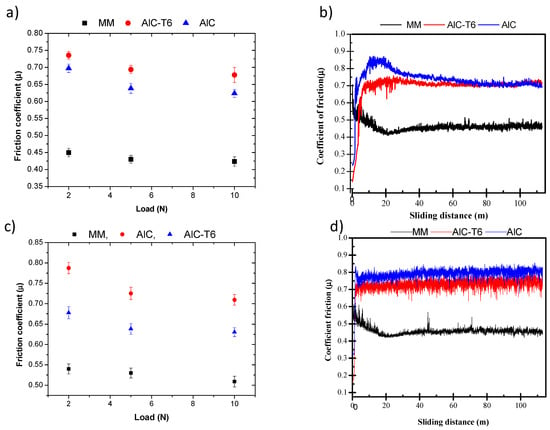
Figure 5.
Mean friction coefficients of Al-MM, AlC, and AlC-T6 at three loading conditions and dynamic friction coefficients at 5 N: in the tribological pairs with (a,b) 52100 steel and (c,d) α-Al2O3, respectively.
In terms of the MMC-Al-2024/TiC in the MMC before and after T6 heat treatment, the behaviour on the µ evolution is similar, but differs from the MM due to the surface heterogeneities. In the first stage, the values of µ are lower and increase gradually. Then, between 20 and 40 m, the value of µ reaches a momentary stationary stage due to the increase in the contact area, the effect of wear hardening, the accumulation of the debris between the tribological pairs and the change in the wear mechanism from two to three contact bodies [43]. The densification on the surface and the presence of oxides after 40 m promote stabilisation of the µ values [53,54], but the presence of some fluctuations is attributed to fractures on the surface. Likewise, the softening of the surfaces in contact promotes the diminution on the µ due to the plastic deformation [51,55]. Finally, in the last stage, a constant oscillation of the µ values up to the end of the sliding due to a softening attributed to the plow effect is observed [23,56]. From plot on Figure 5b, the tribological ceramic–ceramic pair is more stable as a result of the dynamic balance regime between the detached material and the material trapped in the system during the test that promote the formation of a protective tribo-layer [41,42].
The fluctuations observed on the μ in Figure 5 are principally due to the evolution of μ as surface wear and the dependence on the sliding of the tribological pairs in contact. Thus, as roughness and phase distribution on the surface increase, the μ increases due to the enlargement on the actual contact area, where adhesion during sliding is higher with small loads as is reported in other composites [7,9,14,15,16]. On the other hand, it is reported that as load increases, a higher temperature can be reach in situ on the tribological pairs [57]. In terms of the MMC-Al-2024/TiC in the MMC before and after T6 heat treatment, the behaviour on the µ evolution is similar, but differ from the MM due to the surface heterogeneities. In the first stage, the values of µ are lower and increase gradually, then between 20 and 30 m, the value of µ reaches a momentary stationary stage due to the increase in the contact area, the effect of wear hardening, the accumulation of the debris between the tribological pairs and the change in the wear mechanism from two to three contact bodies [53,54]. The densification and the presence of oxides on the surface after 40 m promote stabilisation of the μ values [55,58,59]. SEM analysis indicates that the wear mechanisms on samples are different due to the presence of hard phases. In this context, the MM presents the higher plastic deformation and an increase in the material flow with a coarser surface, where the TiC particles and intermetallic composites limit the matrix flow. At the same time, the heat products of friction during dry sliding induce the formation of aluminium and titanium oxide layers. These layers were fractured as a consequence of the thermal fatigue induced during wear; however, crack propagation was retarded because of the dispersion of TiC particles and the reactive interface between the TiC and MM, especially in the heat-treated samples.
3.3.2. The Wear Rate and the Wear Coefficient, K
The wear coefficient, K, of the MM and the MMC-Al-2024/TiC after 113 m with loads of 2, 5 and 10 N in contact 52100 steel is shown in Figure 6. The K values, obtained with Archard’s law increase as load increases. Nevertheless, the resistance to wear is higher in the MMC after T6 heat treatment due to the presence of the hard TiAl3Si precipitates and the presence of the TiC particles, which increase the resistance to wear. It is well known that the distribution of constituents of a composite determine the mechanical, thermal and electrical properties. In the case of the effect of heat treatment on the MMC-Al-2024/TiC, there is an increase in hardness that is directly proportional to the wear resistance, as was observed on Figure 6, and its relationship with the K coefficient, because of the synergetic effect between the TiC particles and the fine precipitates obtained with the artificial aging of the MM Al 2024 Al alloy. This age hardening mechanism is based on the well-accepted sequence of precipitation αsss → GPZI → GPZII → θ′ → θ and αsss → GPBZ → S′ → S, where hardening of 2024 Al alloy is attributed to the GPZ, corresponding to the Guiner–Preston zones, Cu-solute-rich coherent clusters, θ′ corresponds to the semi-coherent metastable Al2Cu phase, GPBZ corresponds to the Guiner–Preston–Bagariastkij zones with Cu/Mg coherent clusters and S′ corresponds to the semi-coherent Al2CuMg phase [56]. Thus, the among main factors influencing wear resistance is the formation of hard intermetallic phases that increase composite hardness. In this context, Kaczmar [60] evaluated the wear resistance of MMC Al-2024/δ-alumina fibres with and without T6 treatment. The results reveal that MMC-T6 composites showed a reduction in the wear rate by 3-fold than the metallic matrix at normal loads of 0.8 and 1.2 mPa. The MMC-T6 alloy registers greater wear resistance. This behaviour is attributed to rupture of fibres. Similarly, Kim et al. [61] studied wear resistance in composites AISI 1020/TiC. The results showed that the MMC TiC/AISI 1020 exhibited good wear resistance compared with the monolithic metallic matrix, due to uniformly distributed TiC particles in the metallic matrix and hardness increased due to the heat treatment. In contrast, Chelliah et al. [62] studied the effect of T4 heat treatments on composites Mg/TiC. Reported that MMC-T4 showed a higher wear than the composites without heat treatment. The β-phase decreases in heat-treated samples; therefore, composites are more susceptible to oxidation than as cast metal, causing greater wear. The authors found that the COF in MMC-T4 decreases by 4-fold related to the as cast metal, which explains this as a function of the oxide layer formed in composites with heat treatment.
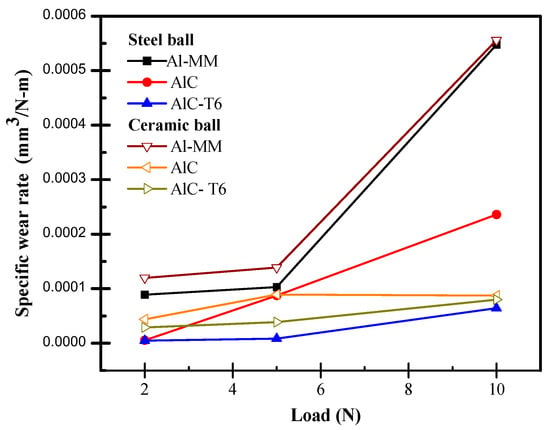
Figure 6.
Variation in the wear rate with respect to the normal load applied in the tribological pairs of MM and AlC in contact with 52100 steel and α-alumina pin.
In general, the wear rate of the tribological pairs of MM and MMC-Al-2024/TiC in contact with α-Al2O3 shows that the K coefficient tends to reduce in the MMC-Al-2024/TiC in comparison with the MM alloy (from 1.3 × 10−4 to 6.4 × 10−5 mm3/N-m), a similar behaviour as was described in the tribological pairs of MM and MMC-Al-2024/TiC in contact with 52100 steel. Nevertheless, in these tribological pairs, the increment in the wear resistance is attributed to the tribochemical reactions that promote the homogeneous formation and dispersion of reaction products in the metallic surface, which can reduce and soften the contact area during the sliding.
Sahin [63] studied the wear behaviour of Al-2014/SiC composites produced by the molten metal mixing method using pin-on-disc tests with Al2O3 and SiC paper emery as counterparts. The results reveal that composites exhibit higher wear resistance than the matrix when normal load and test distance increase in both cases. Although the wear increases in all cases, when Al2O3 is used as the counterpart, the wear rate decreased due to hardening by mechanical work due to longer distances combined with high normal loads and sliding speeds. Moore et al. [60] commented that the material’s hardness determined the wear rate.
3.3.3. SEM Micrograph of Contact Surface
Figure 7 shows the micrographs of the worn surface of the MM 2024 Al alloy sample obtained in the SEM after a wear test with a load of 10 N. The worn surface width obeys a directly proportional relationship between the substrate and the hardness of the counterpart. It is evident that the wear mechanism corresponds to abrasion. According to the EDX result, the dark region is the result of oxidation—in fact, the EDX analysis shows the tribochemical reaction with the formation of an Al- and O-rich layer (Figure 7c,f). Most of the worn surface was covered by these oxidative products. Additionally, Figure 7 shows that the worn surface of the MM against the steel ball presents narrow grooves, while the material against the alumina ball exhibits large wear grooves. Therefore, the predominant wear mechanism was determined as oxidative, delamination and abrasion wear.
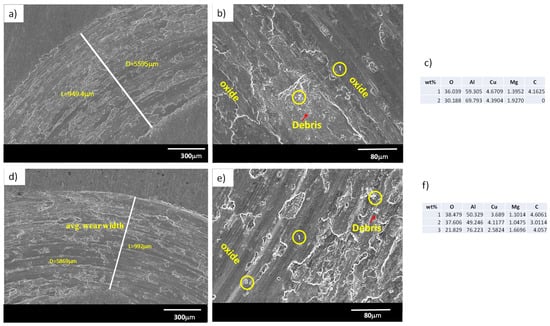
In Figure 8, the worn surface obtained in the SEM of the MMC-Al-2024/TiC after the wear test with a load of 5 and 10 N is shown. The combination of two mechanisms is noted during the wear processes: abrasion and some microcuts are seen in the white lines. Additionally, the presence of white zones is related to the aluminium oxide as a product of the tribochemical reactions that can act as lubricants in the tribological system. Nonetheless, plastic deformation and detachment of the particles are observed, which can increase the abrasive contact in the tribological system at the end of the test [64,65].
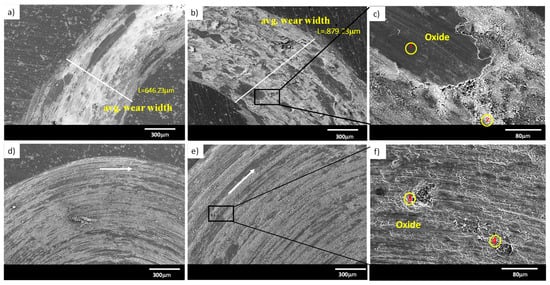
Figure 8.
Worn scars of MMC Al-2024/TiC at 5 and 10 N EDX analysis with (a–c) 52100 steel and (d–f) ceramic ball counterparts.
The analysis of the worn surface In the maximum applied load of 10 N indicates that these loads are not enough to promote the fracture of the reinforcing particles. The EDX shows that there is a loss of material from the counterpart of 52100 steel, attributed to the higher hardness of the particles of TiC present on the MM composite Al-2024/TiC and some agglomeration of compact debris along the worn surface. Even so, the presence of the debris and the formation of oxide layers do not eliminate but reduce the wear of the samples. Withdrawal of the irregularities on the surface promotes an increase in debris that tends to oxidise and is plastically deformed by the counterpart. This debris is in constant comminution and consolidation and eventually forms a protective layer in the surface reducing the contact area and as consequence, the wear rate is reduced [66].
The plastic deformation of the Al2024 matrix is evident, especially at 10 N. Qualitative analyses by EDX were carried out in the areas demarcated (yellow marks) in the images. For both applied loads, the presence of oxygen is observed (Table 3), which suggests the formation of metal oxide films on the worn surfaces as a function of the antifriction, as a consequence of the increase in surface temperature. The increase in load to 10 N led to the presence of furrows (Figure 7b), which suggests greater abrasion; in that event, important amounts of material were displaced plastically towards the edge of the tracks. From the EDX analysis shown in Table 3, high contents of iron were detected, which suggests mass transfer of the 52100 steel ball to the surface of the composite as a result of the abrasion of the wear counterpart.

Table 3.
SEM-EDS compositional analysis of the yellow marks of Figure 8c,f.
3.3.4. The Wear Mechanisms of the Al-2024 Alloy and the Al-2024/TiC Composite
Although three mechanical and chemical surface degradation mechanisms (abrasion, delamination and tribological reaction) were found during the sliding test of the 2024 aluminum and Al-MM composites, with and without the application of the heat treatment with steel 52100 and alumina balls, the predominant mechanism was adhesion, which gives rise to the abrasion of transfer layers. Figure 9a,b shows the aluminum surfaces both sliding against steel and alumina counterfaces, respectively, at a sliding distance of 113 m, a speed rate of 0.03 m/ s and a normal load of 10 N. The morphology of the wear tracks shows the presence of compact waste material in the wear tracks, eventually forming a transfer layer that is formed as a consequence of the agglomeration and compaction of waste material. However, the adhesion of these layers subsequently generates the release of both materials by the abrasive action of the hardened transfer particles, gives rise to the shear, fracture and delamination of the compacted layer, which creates surface abrasion grooves. According to the images, the manner of detachment of the debris confirms the plastic contact experienced by the tribological pair, so different grooves and flanges running parallel to each other in the direction of sliding are visible. This confirms that the changes in the running period in curves of the friction coefficient were caused by lapping the friction couple, and thus the sudden changes in the wear mechanism. On the other hand, the grooves are wider and deeper in samples of metal matrix compared to those of the composites tested under similar conditions, as can be seen in the the SEM micrographs of the MMC and MMC-T6 composites in both tribological pairs tested under the same conditions (Figure 9c–f). This shows that the worn surfaces appear to have progressively more oxidation as the distance increases, which is indicated by the dark regions, especially in the MMC. This is due to the increased temperature by the high friction forces.
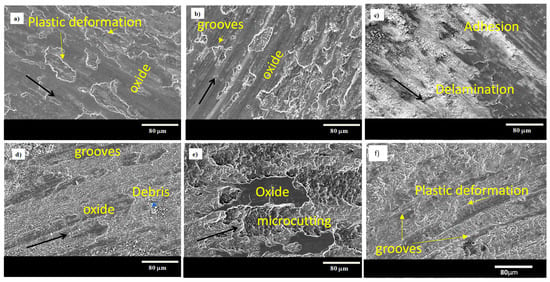
Figure 9.
Morphologies of the worn surface at a load of 10 N, (a,b) aluminum surfaces, (c,d) MMC, and (e,f) MMC-T6 slid with steel and alumina balls as counterfaces, respectively.
A lot of grooves are found among the darker oxidised regions. These were probably caused by the localised melting of matrix material that stretched across the face during sliding which were noted in the sliding direction [25]. The presence of furrows from abrasion due to the slippage of oxide particles in the compound is also observed. From the analysis of the EDX result shown in Figure 8a, the presence of Fe oxides from the 52100 steel and aluminum oxide (Figure 8b) from the alumina counterpart is observed, which generates the formation of protective layers of thicker transfer, which inhibits the contact in the tribological pair, achieving less wear in the composites. This indicates the possibility of the longer lifetime of MMC and MMC-T6 material under high abrasion.
At the end of the test, several kinds of wear mechanisms were found. Table 4 shows the quantification of the wear mechanisms present on samples. In the MM (Al-2024), at low load (2 N), abrasion was dominant and a small amount of the oxide is observed; but, under high loads (10 N), and fatigue is being reached due to the high loads and the increment in temperature in situ during the sliding test [50]. In the case of the composites MMC, oxidative and abrasion mechanisms were dominant; after heat treatment T6, the higher hardness of the composites improves their load-bearing capacity leading to better resistance to adhesive wear [51]. However, at 10 N, fatigue is reached, followed by a reduction in the abrasion.

Table 4.
Wear mechanisms present over worn tracks of samples.
3.3.5. Optical Profilometry Analysis
The representative morphology of the worn surface of the samples with a load of 10 N of both counterparts—the α-Al2O3 ball and steel 52100—was analysed in the optical profilometer and is shown in Figure 10a–f. The cross-section profile of each specimen was measured three times. The wear volumes were calculated based on the obtained wear area of the cross-section profiles of each sample.
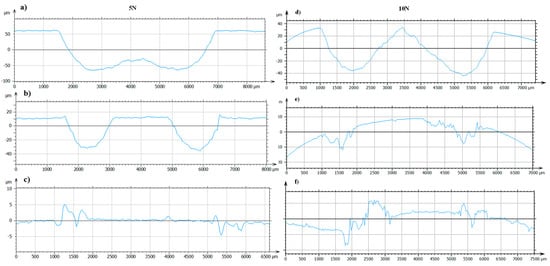
Figure 10.
Profile of the worn surfaces obtained in the optical profilometer after a tribological test at 5 and 10 N, respectively, in (a,d) MM, (b,e) MMC and (c,f) MMC-T6.
The comparison of the width and depth of the worn surfaces indicates that MM, Figure 10 a,d, presents greater damage than the MMC-Al-2024/TiC, Figure 10b,e, and after heat treatment, Figure 10c,f. Observations indicate that damage is reduced by 50% in the MMC-Al-2024/TiC and by 70% after heat treatment. These observations correlate well with those found for Mg/SiC composites reported by Manoj Kumar et al. [66], who relate the increase in wear resistance to the increase in hardness added by reinforcing particles and the diffusion of reactive products from the monolithic matrix.
Profiles of MMC-Al-2024/TiC samples exhibit a noisy line in the periphery due to the higher roughness by the presence of the TiC particles in the MM. Under the application of load, there is plastic deformation of the aluminium matrix, which, in addition to the abrasion, leads to the presence of pile up of plastic strain matter around the wear scar, including hard particles or fragments that are driven by the plastic flow. However, with different depths, the composites in both counterparts show similar wear profiles. There are signs of fragmentation and detachment of particles from the ceramic counterpart, which increase the abrasive effect in the tribological pairs as observed in Figure 8 and Figure 9. As observed in Figure 10 c,f, the depth of the wear scars in the optimal T6 condition of MMC decreased, indicating a better wear resistance at maximum normal loads applied in this experiment. Additionally, the irregularities of the surface in the contact area indicate the occurrence of adhesion, forming the oxidative and brittle layer that modifies the contact of the tribological pair due to an eventual fracture as a result of thermal fatigue induced during wear.
4. Conclusions
The present investigation has led to the following conclusions.
- Al-2024/TiC metal matrix composite was manufactured using the presureless melt infiltration route.
- The presence of Al3Ti and Al3TiSi0.23 was detected by XRD analysis. However, during heat treatment, this phase was partially redispersed into the metallic matrix.
- Through heat treatment, the composites present better mechanical properties whereas ductility decreases. The tensile properties are seen to vary significantly with ageing treatment. The highest strengths were obtained for the solution heat-treated Al-2024/TiC composites, where the tensile strength increased from 360 to 400 MPa after heat treatment.
- The as-fabricated composites have an elastic modulus and hardness of 195 GPa and 289 Hv, 25 HRC, respectively. After solution heat treatment and aging at 530 °C over 12 h, the composites reached values of 197 GPa and 343 Hv, 34HRC for the elastic modulus and hardness, respectively.
- The wear rate was higher for the metal matrix Al-2024 alloy when compared to the Al-2024/TiC-reinforced composites.
- The oxidation of aluminium surfaces has a beneficial effect in reducing wear during sliding of aluminium, particularly by preventing metal–metal contact.
- High-friction interfaces exhibit lower wear rates. This may be attributed to the higher hardness of the composite due to the incorporation of hard TiC particles, resulting in a lower actual contact area.
- The wear rate increases linearly with increasing normal load following Archard’s law.
- Results revealed that T6 heat treatment is a suitable option for the increase in the wear resistance of the Al-2024/TiC composites.
- Abrasive wear was the dominant mechanism in MM samples, and oxidative wear was dominant in the MMC. Oxidative products present on worn tracks acted as lubricants, reducing the wear of MMCs.
Author Contributions
Formal analysis, J.G.-G.; investigation, S.E.F.-V.; project administration, E.B.-B.; resources, E.B.-B.; software, S.G.-V.; validation, V.H.L.-M.; visualisation, S.E.F.-V.; writing—original draft, J.G.-G.; writing—review and editing, V.H.L.-M., M.A.G.-R., L.A.F.-F., V.H.M.-L. and S.G.-V. All authors have read and agreed to the published version of the manuscript.
Funding
This work was supported by the National Council of Science and Technology (CONACyT) [grant number 0220913].
Institutional Review Board Statement
Not applicable.
Informed Consent Statement
Not applicable.
Data Availability Statement
The data presented in this study are available on request from the corresponding author. The data are not publicly available due to the extremely large size.
Acknowledgments
The authors gratefully acknowledge financial support from the National Council of Science and Technology (CONACyT) under Grant 0220913. Also, the authors are grateful for the experimental support received from Universidad Michoacana de San Nicolás de Hidalgo and Universidad Autónoma de Coahuila.
Conflicts of Interest
The authors declare no conflict of interest.
References
- Zhang, Z.F.; Zhang, L.C.; Mai, Y.W. Particle effects on friction and wear of aluminium matrix composites. J. Mater. Sci. 1995, 30, 5999–6004. [Google Scholar] [CrossRef]
- Nieto, A.; Yang, H.; Jiang, L.; Schoenung, J.M. Reinforcement size effects on the abrasive wear of boron carbide reinforced aluminum composites. Wear 2017, 390–391, 228–235. [Google Scholar] [CrossRef]
- Alahelisten, A.; Bergman, F.; Olsson, M.; Hogmark, S. On the wear of aluminium and magnesium metal matrix composites. Wear 1993, 165, 221–226. [Google Scholar] [CrossRef]
- Aribo, S.; Fakorede, A.; Ige, O.; Olubambi, P. Erosion-corrosion behaviour of aluminum alloy 6063 hybrid composite. Wear 2017, 376–377, 608–614. [Google Scholar] [CrossRef]
- Campbell, F. Manufacturing Technology for Aerospace Structural Materials; Butterworth-Heineman, Elsivier Publications: New York, NY, USA, 2006. [Google Scholar]
- Meyveci, A.; Karacan, İ.; Çalıgülü, U.; Durmuş, H. Pin-on-disc characterization of 2xxx and 6xxx aluminium alloys aged by precipitation age hardening. J. Alloys Compd. 2010, 491, 278–283. [Google Scholar] [CrossRef]
- Wu, L.; Zhou, C.; Li, X.; Ma, N.; Wang, H. Microstructural evolution and mechanical properties of cast high-Li-content TiB2/Al-Li-Cu composite during heat treatment. J. Alloys Compd. 2018, 739, 270–279. [Google Scholar] [CrossRef]
- Benal, M.M.; Shivanand, H.K. Effects of reinforcements content and ageing durations on wear characteristics of Al (6061) based hybrid composites. Wear 2007, 262, 759–763. [Google Scholar] [CrossRef]
- Röttger, A.; Weber, S.L.; Theisen, W. Influence of post-treatment on the microstructural evolution of thermally sprayed Fe-base MMC containing TiC and Cr3C2. Surf. Coat. Technol. 2012, 209, 151–159. [Google Scholar] [CrossRef]
- Albiter, A.; León, C.A.; Drew, R.A.L.; Bedolla, E. Microstructure and heat-treatment response of Al-2024/TiC composites. Mater. Sci. Eng. A 2000, 289, 109–115. [Google Scholar] [CrossRef]
- Reyes, A.; Bedolla, E.; Perez, R.; Contreras, A. Effect of heat treatment on the mechanical and microstructural characterization of Mg-AZ91E/TiC composites. Compos. Interfaces 2017, 24, 593–609. [Google Scholar] [CrossRef]
- Vijaya Ramnath, B.; Elanchezhian, C.; Jaivignesh, M.; Rajesh, S.; Parswajinan, C.; Siddique Ahmed Ghias, A. Evaluation of mechanical properties of aluminium alloy–alumina–boron carbide metal matrix composites. Mater. Des. 2014, 58, 332–338. [Google Scholar] [CrossRef]
- Kok, M. Production and mechanical properties of Al2O3 particle-reinforced 2024 aluminium alloy composites. J. Mater. Process. Technol. 2005, 161, 381–387. [Google Scholar] [CrossRef]
- Kumar, A.; Jha, P.K.; Mahapatra, M.M. Abrasive Wear Behavior of In Situ TiC Reinforced with Al-4.5%Cu Matrix. J. Mater. Eng. Perform. 2014, 23, 743–752. [Google Scholar] [CrossRef]
- Lee, K.B.; Sim, H.S.; Kwon, H. Reaction products of Al/TiC composites fabricated by the pressureless infiltration technique. Metall. Mater. Trans. A 2005, 36, 2517–2527. [Google Scholar] [CrossRef]
- Leon, C.A.; Lopez, V.H.; Bedolla, E.; Drew, R.A.L. Wettability of TiC by commercial aluminum alloys. J. Mater. Sci. 2002, 37, 3509–3514. [Google Scholar] [CrossRef]
- Veeravalli, R.R.; Nallu, R.; Mohammed Moulana Mohiuddin, S. Mechanical and tribological properties of AA7075–TiC metal matrix composites under heat treated (T6) and cast conditions. J. Mater. Res. Technol. 2016, 5, 377–383. [Google Scholar] [CrossRef]
- Zhang, S.-c.; Pan, Q.-l.; Yan, J.; Huang, X. Effects of sliding velocity and normal load on tribological behavior of aged Al-Sn-Cu alloy. Trans. Nonferrous Met. Soc. China 2016, 26, 1809–1819. [Google Scholar] [CrossRef]
- Sharma, S.; Nanda, T.; Pandey, O.P. Effect of particle size on dry sliding wear behaviour of sillimanite reinforced aluminium matrix composites. Ceram. Int. 2018, 44, 104–114. [Google Scholar] [CrossRef]
- Surappa, M.K.; Prasad, S.V.; Rohatgi, P.K. Wear and abrasion of cast Al-Alumina particle composites. Wear 1982, 77, 295–302. [Google Scholar] [CrossRef]
- Jerome, S.; Ravisankar, B.; Kumar Mahato, P.; Natarajan, S. Synthesis and evaluation of mechanical and high temperature tribological properties of in-situ Al–TiC composites. Tribol. Int. 2010, 43, 2029–2036. [Google Scholar] [CrossRef]
- Gopalakrishnan, S.; Murugan, N. Production and wear characterisation of AA 6061 matrix titanium carbide particulate reinforced composite by enhanced stir casting method. Compos. Part B Eng. 2012, 43, 302–308. [Google Scholar] [CrossRef]
- Modi, O.P. Two-body abrasion of a cast Al–Cu (2014 Al) alloy–Al2O3 particle composite: Influence of heat treatment and abrasion test parameters. Wear 2001, 248, 100–111. [Google Scholar] [CrossRef]
- Roy, M.; Venkataraman, B.; Bhanuprasad, V.V.; Mahajan, Y.R.; Sundararajan, G. The effect of participate reinforcement on the sliding wear behavior of aluminum matrix composites. Metall. Trans. A 1992, 23, 2833–2847. [Google Scholar] [CrossRef]
- Paknia, A.; Pramanik, A.; Dixit, A.R.; Chattopadhyaya, S. Effect of Size, Content and Shape of Reinforcements on the Behavior of Metal Matrix Composites (MMCs) Under Tension. J. Mater. Eng. Perform. 2016, 25, 4444–4459. [Google Scholar] [CrossRef]
- Shojaeefard, M.H.; Akbari, M.; Asadi, P.; Khalkhali, A. The effect of reinforcement type on the microstructure, mechanical properties, and wear resistance of A356 matrix composites produced by FSP. Int. J. Adv. Manuf. Technol. 2017, 91, 1391–1407. [Google Scholar] [CrossRef]
- Tyagi, R. Synthesis and tribological characterization of in situ cast Al–TiC composites. Wear 2005, 259, 569–576. [Google Scholar] [CrossRef]
- Mohammad, A.C.; Maksud, H. The frictional behavior of composite materials under horizontal vibration. Ind. Lubr. Tribol. 2009, 61, 246–253. [Google Scholar] [CrossRef]
- Kaushik, N.C.; Rao, R.N. Effect of grit size on two body abrasive wear of Al 6082 hybrid composites produced by stir casting method. Tribol. Int. 2016, 102, 52–60. [Google Scholar] [CrossRef]
- ASTM C373-88; Standard Test Method for Water Absorption, Bulk Density, Apparent Porosity, and Apparent Specific Gravity of Fired Whiteware Products. ASTM International: West Conshohocken, PA, USA, 2006.
- Albiter, A.; Contreras, A.; Bedolla, E.; Perez, R. Structural and chemical characterization of precipitates in Al-2024/TiC composites. Compos. Part A Appl. Sci. Manuf. 2003, 34, 17–24. [Google Scholar] [CrossRef]
- ASTM E384-17; Standard Test Method for Microindentation Hardness of Materials. ASTM International: West Conshohocken, PA, USA, 2017.
- ASTM G99-05; Standard Test Method for Wear Testing with a Pin-on-Disk Apparatus. ASTM International: West Conshohocken, PA, USA, 2016.
- León-Patiño, C.A.; Braulio-Sánchez, M.; Aguilar-Reyes, E.A.; Bedolla-Becerril, E.; Bedolla-Jacuinde, A. Dry sliding wear behavior of infiltrated particulate reinforced Ni/TiC composites. Wear 2019, 426–427, 989–995. [Google Scholar] [CrossRef]
- Menezes, P.L.; Nosonovsky, M.; Ingole, S.P.; Kailas, S.V.; Lovell, M.R. Tribology for Scientists and Engineers, 1st ed.; Springer: New York, NY, USA, 2013. [Google Scholar] [CrossRef]
- López, V.H.; Kennedy, A.R.; Lemus, J. Characterization of the reactivity in Al-10wt.%TiC metal matrix composites by image analysis. Kov. Mater. 2010, 48, 17–24. [Google Scholar] [CrossRef]
- López, V.H.; Scoles, A.; Kennedy, A.R. The thermal stability of TiC particles in an Al7wt.%Si alloy. Mater. Sci. Eng. A 2003, 356, 316–325. [Google Scholar] [CrossRef]
- Li, G.-R.; Wang, H.-M.; Zhao, Y.-T.; Chen, D.-B.; Chen, G.; Cheng, X.-N. Microstructure of in situ Al3Ti/6351Al composites fabricated with electromagnetic stirring and fluxes. Trans. Nonferrous Met. Soc. China 2010, 20, 577–583. [Google Scholar] [CrossRef]
- Mehrizi, M.Z.; Beygi, R.; Eisaabadi, G. Synthesis of Al/TiC–Al2O3 nanocomposite by mechanical alloying and subsequent heat treatment. Ceram. Int. 2016, 42, 8895–8899. [Google Scholar] [CrossRef]
- Muscat, D.; Shanker, K.; Drew, R.A.L. Al/TiC composites produced by melt infiltration. Mater. Sci. Technol. 1992, 8, 971–976. [Google Scholar] [CrossRef]
- Yasmin, T.; Khalid, A.A.; Haque, M.M. Tribological (wear) properties of aluminum–silicon eutectic base alloy under dry sliding condition. J. Mater. Process. Technol. 2004, 153–154, 833–838. [Google Scholar] [CrossRef]
- Tao, J.; Zhang, L.; Wu, G.; Chen, A.; Zhang, X.; Shi, C. Effect of heat treatment on the microstructure and mechanical properties of extruded Al–4Cu–1Li–0.4Mg–0.4Ag–0.18Zr Alloy. Mater. Sci. Eng. A 2018, 717, 11–19. [Google Scholar] [CrossRef]
- Vissers, R.; van Huis, M.A.; Jansen, J.; Zandbergen, H.W.; Marioara, C.D.; Andersen, S.J. The crystal structure of the β′ phase in Al–Mg–Si alloys. Acta Mater. 2007, 55, 3815–3823. [Google Scholar] [CrossRef]
- Kiourtsidis, G.E.; Skolianos, S.M.; Litsardakis, G.A. Aging response of aluminium alloy 2024/silicon carbide particles (SiCp) composites. Mater. Sci. Eng. A 2004, 382, 351–361. [Google Scholar] [CrossRef]
- Bekheet, N.E.; Gadelrab, R.M.; Salah, M.F.; Abd El-Azim, A.N. The effects of aging on the hardness and fatigue behavior of 2024 Al alloy/SiC composites. Mater. Des. 2002, 23, 153–159. [Google Scholar] [CrossRef]
- Su, Y.; Ouyang, Q.; Zhang, W.; Li, Z.; Guo, Q.; Fan, G.; Zhang, D. Composite structure modeling and mechanical behavior of particle reinforced metal matrix composites. Mater. Sci. Eng. A 2014, 597, 359–369. [Google Scholar] [CrossRef]
- Satyaprasad, K.; Mahajan, Y.R.; Bhanuprasad, V.V. Strengthening of Al/20 v/o TiC composites by isothermal heat treatment. Scr. Metall. Et Mater. 1992, 26, 711–716. [Google Scholar] [CrossRef]
- Yahya Altunpak, A.H.A. Mechanical properties of a squeeze-cast 2124 Al composite reinforced with alumina short fibre. Metall. Res. Technol. 2017, 114, 509. [Google Scholar] [CrossRef]
- Lu, G.; Shi, X.; Liu, X.; Zhou, H.; Chen, Y.; Yang, Z.; Huang, Y. Tribological performance of functionally gradient structure of graphene nanoplatelets reinforced Ni3Al metal matrix composites prepared by laser melting deposition. Wear 2019, 428–429, 417–429. [Google Scholar] [CrossRef]
- Tyagi, R.; Xiong, D.; Li, J. Effect of load and sliding speed on friction and wear behavior of silver/h-BN containing Ni-base P/M composites. Wear 2011, 270, 423–430. [Google Scholar] [CrossRef]
- Bhushan, B. Introduction to Tribology, 2nd ed.; John Wiley and Sons: New York, NY, USA, 2002. [Google Scholar]
- ASTM. Annual Book of ASTM Standards, G115-93. In Standard Guide for Measuring and Reporting Friction; ASTM: Philadrelphia PA, USA, 1995. [Google Scholar]
- Asif, M.; Chandra, K.; Misra, P.S. Development of Aluminium Based Hybrid Metal Matrix Composites for Heavy Duty Applications. J. Miner. Mater. Charact. Eng. 2011, 10, 1337–1344. [Google Scholar] [CrossRef]
- Bowden, F.P.; Bowden, F.P.; Tabor, D. The Friction and Lubrication of Solids; Clarendon Press: Oxford, UK, 2001; Volume 1. [Google Scholar]
- Abis, S.; Massazza, M.; Mengucci, P.; Riontino, G. Early ageing mechanisms in a high-copper AlCuMg alloy. Scr. Mater. 2001, 45, 685–691. [Google Scholar] [CrossRef]
- Natarajan, N.; Vijayarangan, S.; Rajendran, I. Wear behaviour of A356/25SiCp aluminium matrix composites sliding against automobile friction material. Wear 2006, 261, 812–822. [Google Scholar] [CrossRef]
- Babic, M.; Mitrovic, S.; Ninkovic, R. Tribological Potencial of ZincAluminium Alloys Improvement. Tribol. Ind. 2009, 31, 15–28. [Google Scholar]
- Uthayakumar, M.; Aravindan, S.; Rajkumar, K. Wear performance of Al–SiC–B4C hybrid composites under dry sliding conditions. Mater. Des. 2013, 47, 456–464. [Google Scholar] [CrossRef]
- Kaczmar, J.W.; Naplocha, K. Wear behaviour of composite materials based on 2024 Al-alloy reinforced with alumina fibres. JAMME 2010, 43, 6. [Google Scholar]
- Kim, H.; Park, J.; Shin, S.; Cho, S.; Kim, J.; Bae, D.S.; Jo, I. Microstructure and wear behaviour of TiC/AISI 1020 Metal Matrix Composites Produced by Liquid Processing Infiltration. Appl. Sci 2021, 11, 9682. [Google Scholar] [CrossRef]
- Chelliah, N.M.; Singh, H.; Surappa, M.K. Correlation between microstructure and wear behavior of AZX915 Mg-alloy reinforced with 12 wt% TiC particles by stir-casting process. J. Magnes. Alloy. 2016, 4, 306–313. [Google Scholar] [CrossRef]
- Şahin, Y. Abrasive wear behaviour of SiC/2014 aluminium composite. Tribol. Int. 2010, 43, 939–943. [Google Scholar] [CrossRef]
- Lee, C.S.; Kim, Y.H.; Han, K.S.; Lim, T. Wear behaviour of aluminium matrix composite materials. J. Mater. Sci. 1992, 27, 793–800. [Google Scholar] [CrossRef]
- Lekatou, A.; Karantzalis, A.E.; Evangelou, A.; Gousia, V.; Kaptay, G.; Gácsi, Z.; Baumli, P.; Simon, A. Aluminium reinforced by WC and TiC nanoparticles (ex-situ) and aluminide particles (in-situ): Microstructure, wear and corrosion behaviour. Mater. Des. 2015, 65, 1121–1135. [Google Scholar] [CrossRef]
- Pramanik, A. Effects of reinforcement on wear resistance of aluminum matrix composites. Trans. Nonferrous Met. Soc. China 2016, 26, 348–358. [Google Scholar] [CrossRef]
- Kumar, B.V.M.; Basu, B.; Murthy, V.S.R.; Gupta, M. The role of tribochemistry on fretting wear of Mg–SiC particulate composites. Compos. Part A Appl. Sci. Manuf. 2005, 36, 13–23. [Google Scholar] [CrossRef]
Disclaimer/Publisher’s Note: The statements, opinions and data contained in all publications are solely those of the individual author(s) and contributor(s) and not of MDPI and/or the editor(s). MDPI and/or the editor(s) disclaim responsibility for any injury to people or property resulting from any ideas, methods, instructions or products referred to in the content. |
© 2022 by the authors. Licensee MDPI, Basel, Switzerland. This article is an open access article distributed under the terms and conditions of the Creative Commons Attribution (CC BY) license (https://creativecommons.org/licenses/by/4.0/).